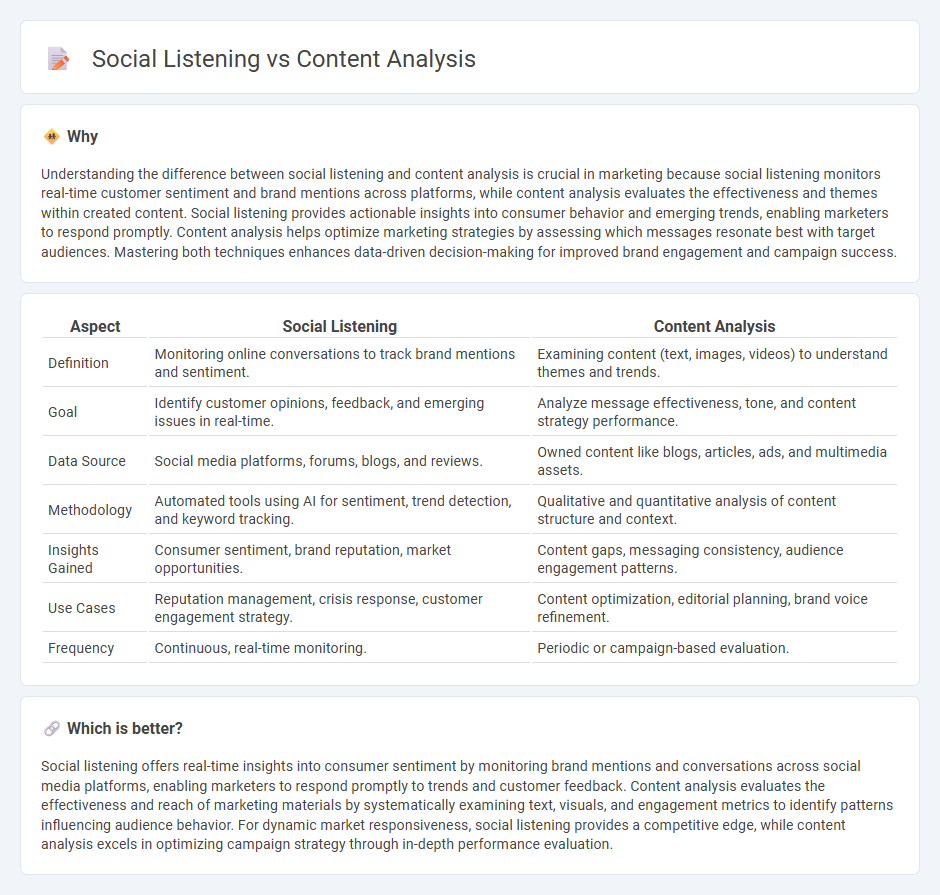
Social listening monitors real-time conversations and trends on social media platforms, enabling brands to gauge customer sentiment and respond promptly. Content analysis examines the quality, themes, and effectiveness of published materials to optimize messaging and engagement strategies. Discover how integrating social listening with content analysis can elevate your marketing efforts.
Why it is important
Understanding the difference between social listening and content analysis is crucial in marketing because social listening monitors real-time customer sentiment and brand mentions across platforms, while content analysis evaluates the effectiveness and themes within created content. Social listening provides actionable insights into consumer behavior and emerging trends, enabling marketers to respond promptly. Content analysis helps optimize marketing strategies by assessing which messages resonate best with target audiences. Mastering both techniques enhances data-driven decision-making for improved brand engagement and campaign success.
Comparison Table
| Aspect | Social Listening | Content Analysis |
|---|---|---|
| Definition | Monitoring online conversations to track brand mentions and sentiment. | Examining content (text, images, videos) to understand themes and trends. |
| Goal | Identify customer opinions, feedback, and emerging issues in real-time. | Analyze message effectiveness, tone, and content strategy performance. |
| Data Source | Social media platforms, forums, blogs, and reviews. | Owned content like blogs, articles, ads, and multimedia assets. |
| Methodology | Automated tools using AI for sentiment, trend detection, and keyword tracking. | Qualitative and quantitative analysis of content structure and context. |
| Insights Gained | Consumer sentiment, brand reputation, market opportunities. | Content gaps, messaging consistency, audience engagement patterns. |
| Use Cases | Reputation management, crisis response, customer engagement strategy. | Content optimization, editorial planning, brand voice refinement. |
| Frequency | Continuous, real-time monitoring. | Periodic or campaign-based evaluation. |
Which is better?
Social listening offers real-time insights into consumer sentiment by monitoring brand mentions and conversations across social media platforms, enabling marketers to respond promptly to trends and customer feedback. Content analysis evaluates the effectiveness and reach of marketing materials by systematically examining text, visuals, and engagement metrics to identify patterns influencing audience behavior. For dynamic market responsiveness, social listening provides a competitive edge, while content analysis excels in optimizing campaign strategy through in-depth performance evaluation.
Connection
Social listening captures real-time consumer conversations across social media and online platforms, providing rich data for content analysis to identify trending topics, sentiment, and audience preferences. Content analysis then interprets this data to optimize marketing strategies by tailoring messages that resonate with target demographics. This integration enhances brand responsiveness and drives more effective, data-driven marketing campaigns.
Key Terms
Content Analysis:
Content analysis systematically examines textual, visual, or audio data to identify patterns, themes, and sentiments within large datasets. This method employs quantitative and qualitative techniques to decode meaning, frequency, and relationships in media such as articles, reports, and social media posts. Discover how mastering content analysis can unlock valuable insights for your research or marketing strategy.
Thematic Coding
Thematic coding in content analysis involves systematically categorizing qualitative data to identify patterns and themes within texts, enabling detailed insights into communication content. Social listening applies thematic coding to monitor and analyze online conversations, tracking customer sentiments and emerging trends across social media platforms. Discover how thematic coding enhances both methodologies by providing structured, actionable insights in digital communication analysis.
Textual Data
Content analysis systematically examines textual data to identify patterns, themes, and sentiments across large datasets, offering structured insights into communication. Social listening monitors real-time social media conversations and online mentions to capture audience opinions, trends, and emerging issues related to brands or topics. Explore deeper differences and applications of these methods to enhance your data-driven strategies.
Source and External Links
Content Analysis vs Thematic Analysis: What's the Difference? - Delve - Content analysis is a technique used to identify the presence of certain words, themes, or concepts within qualitative data to describe the characteristics of the content, aiming to understand themes, patterns, and quantify qualitative data for theoretical insights.
Content analysis - Wikipedia - Content analysis studies documents and communication artifacts, often combined with other qualitative methods like discourse or thematic analysis, to systematically identify patterns and meanings in large datasets of texts such as photos, speeches, or essays.
Content Analysis Method and Examples | Columbia Public Health - Content analysis is a research tool used to quantify and analyze the presence, meanings, and relationships of certain words or themes within text data, involving coding into categories to focus on concepts and either counting their occurrence or frequency.
 dowidth.com
dowidth.com